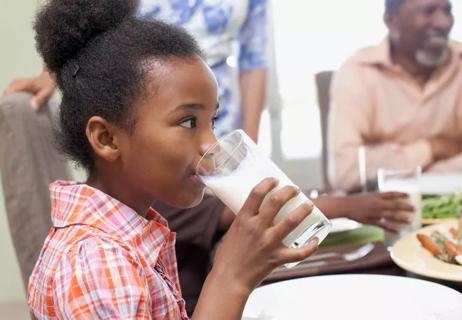Experiment with numerous dairy alternatives or try taking a lactase enzyme medication before you eat dairy

If you’ve ever had horrible cramps, increased gas and bouts of seemingly endless diarrhea whenever you’ve had dairy products, like cheese, milk or ice cream, it’s possible that you’re lactose intolerant.
Advertisement
Cleveland Clinic is a non-profit academic medical center. Advertising on our site helps support our mission. We do not endorse non-Cleveland Clinic products or services. Policy
Having such strong reactions to the foods you love can likely turn you off of them, at least for a little while. But when you’re lactose intolerant, do you have to give up ice cream sundaes and cream cheese-slathered bagels forever?
Gastroenterologist Christine Lee, MD, says living with lactose intolerance comes down to reducing the severity of your symptoms without feeling like you’re compromising on the foods you love.
“Simple lifestyle modifications can help,” says Dr. Lee. “For those who’ve had violent diarrhea or they were so sick and wiped out that they never want to experience dairy products again, there are so many milk alternatives out there and things you can do to reduce those violent experiences from ever happening.”
Here’s what you can do to make the most out of lactose intolerance.
Lactose is a natural complex sugar (disaccharide) that’s produced in all mammalian milk, so it’s often highest in:
If your body isn’t capable of producing enough lactase proteins to break down large amounts of lactose, then you’ll want to limit lactose-heavy foods whenever possible.
Advertisement
But that doesn’t always mean you have to give them up entirely. If you decide to keep eating these products, you’ll need to listen to your body and learn how much you can have before it begins to negatively affect you.
“If you really like milk or other dairy products and you don’t want to give them up, I would start with a very small amount, maybe 1 ounce, and see how that goes,” advises Dr. Lee. “If that goes well, then the next day, try having 2 ounces. And then, go up slowly from there and figure out where your threshold is.”
There are plenty of lactose-free, plant-based milk alternatives like:
These alternative milks come sweetened or unsweetened. You can drink them on their own or enjoy them in other products like vegan ice cream, puddings, brownies, pasta sauce and more. There’s also lactose-free cow’s milk, but that can sometimes be hit-or-miss depending on your body’s ability to break down lactose.
“If you happen to be someone who doesn’t produce any lactase at all, you could give lactose-free milk a try but it may or may not work for you,” cautions Dr. Lee. “Even though it’s labeled ‘lactose-free milk,’ you may still have some lactose in there because some disaccharides can fall through the cracks and don’t get filtered out.”
You’ll also want to switch out soft cheeses with hard cheeses, like Parmesan, and may even want to try other ice cream alternatives, like sorbet. Nut butters are also great alternative spreads when replacing dairy-based mayo and butter.
Still not sold on any of the alternatives? That’s OK — try taking a lactase enzyme product like Lactaid® right before you eat anything with lactose in it.
“How much you need depends on what you’re eating,” clarifies Dr. Lee. “If you’re having a small container of yogurt, you may only need one or two lactase tablets. If you’re drinking an 8-ounce glass of milk and having a New York-style cheese pizza, you may need three or four tablets.”
Note: These over-the-counter supplements aren’t always 100% effective, especially if your reaction to lactose is severe. So, if you’re trying lactase medications for the first time, start taking them with small amounts of lactose-laden products. You also want to be wary of taking ultra-fast lactase products, as these sometimes double or triple the dose of lactase compared to the original versions of the same medication.
If you have doubts about what’s safe to take and how to use these products, talk to your healthcare provider before trying them.
Advertisement
Slip-ups are bound to happen. You may inevitably be faced with a bout of diarrhea from time to time if you forget to take a lactase enzyme product before eating or if you have one too many scoops of ice cream. When this happens, it’s important to manage your symptoms in an effort to bounce back quickly and efficiently.
Adjusting your diet to include more fiber can help your poops return to normal, and over-the-counter medications like bismuth subsalicylate (Pepto-Bismol®) can also help calm down the flood of diarrhea.
People who are lactose intolerant sometimes run the risk of losing much-needed calcium when they avoid dairy products. As you make changes to reduce the severity of your symptoms, it may be worth boosting the amount of calcium you consume with calcium-fortified products like:
Prebiotics and probiotics won’t help your body produce the lactase that’s needed to digest dairy products, but they can be helpful in keeping your gut healthy regardless of what it comes up against. After all, eating healthy is a key part of staying healthy.
“No matter what condition you have, we should all be eating a wide variety of colorful foods,” says Dr. Lee. “You want to keep your intestines healthy and you want to eat natural foods with lots of probiotics like fermented foods, sauerkraut, cabbages, onions and garlic.”
Advertisement
Advertisement
Learn more about our editorial process.
Advertisement

Medications, dietary changes, abdominal massage and physical activity can all help you start to feel better

Lactose is difficult to breakdown and digest because of its complexity

Be aware of the signs and symptoms of this digestive problem

Alpha-gal syndrome has become more common and is a leading cause of anaphylaxis

It’s not an enema or bowel prep, and this colonic hydrotherapy can harm proper colon function

Family history can increase your risk of developing this autoimmune disorder — you may want to see a healthcare provider for screening

Choose foods that are easily broken down in your digestive system, like fruits and vegetables without skins or seeds

Focus on exercise, eating healthy and getting regular screenings to help lower your risk

If you’re feeling short of breath, sleep can be tough — propping yourself up or sleeping on your side may help

If you fear the unknown or find yourself needing reassurance often, you may identify with this attachment style

If you’re looking to boost your gut health, it’s better to get fiber from whole foods